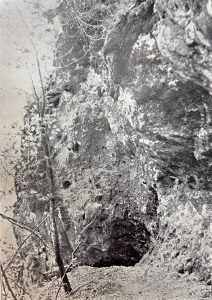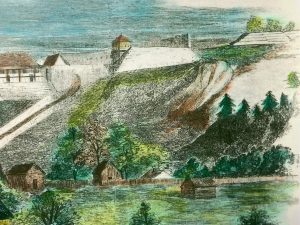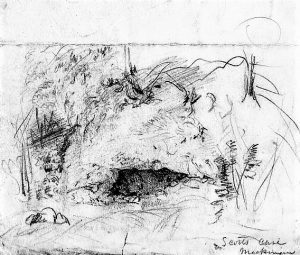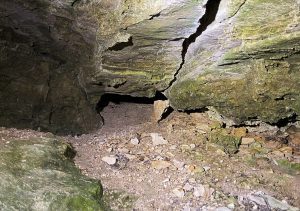“It is absolutely beyond my power in a letter like this to give you a proper delineation of the objects seen in this extraordinary cave.” J.M.W. (July 1855)

The natural wonders of Mackinac Island have drawn people to its rocky shores for thousands of years. Described as “one mass of limestone,” the island first emerged after the last ice age, about 11,000 years ago. Post-glacial lakes gradually sculpted Mackinac’s durable breccia, forming arches, sea stacks, cliffs, and caves. Features such as Arch Rock, Sugar Loaf, and Skull Cave, have been renowned for centuries and are visited often.
Just beneath the surface, however, are stories of fantastic discoveries, now long forgotten. While the Musical Well once captivated listeners, its tunes had fallen silent by 1845. Scott’s Cave, where “the giant Goliath might stand erect,” was destroyed in the early 1950s. Fairy Arch has fallen and Wishing Spring no longer invites visitors to its “fragrant, fairy grotto.”
Most enticing of all are tales of large caverns beneath the island’s surface. In 1892, Harold Corbusier, son of the post surgeon, explored a winding cavern with a small party, including several soldiers. With the aid of ropes, they were lowered about 20 feet, making their way to “a large chamber with branches leading away in different directions.”
“Another Mammoth Cave Discovered”

The greatest discovery reportedly occurred in July 1855, when sensational news broke of a newly-discovered cavern on Mackinac Island. The original account was penned by J.M.W., a correspondent of the Detroit Tribune. Reprinted in newspapers from coast-to-coast, the find was often compared to Mammoth Cave in Kentucky.
“The day before yesterday, a tremendous storm sprang up,” he wrote, “accompanied by the fiercest thunder and lightning I ever witnessed … Streams ran through the streets, tearing them in ridges; and the little board race at the Garrison gate roared and threw the spray like a young cataract; rocks, stones, and gravel were displaced in quantities from the brow of the bluff.
The following morning, boys in going along the base of the Fort hill, east of their stables, found that several large masses of rock had been displaced by the rain and rolled down from their original beds. One large one was noticed, having left an opening of some 4 feet by 10. Some of the boldest of the boys immediately explored as far as the light would admit. The report spread far and near and many people soon came and examined the entrance. Finally, a party of gentlemen and ladies was organized to explore the opening the following morning …
The party of ladies and gentlemen before alluded to, having provided themselves with lights, cords, arms and eatables, entered the new-found opening. The entrance is small, not being over four feet high by ten feet in width, descending gradually after passing through a long and rather narrow alley surrounded on every side by stalactites and small crystals of calcareous spar, which glittered in the torch-lights like diamonds. We after some time entered a dome or amphitheater; we stood transfixed in astonishment. The dome is 350 feet in length by 240 in width, and in most places 180 feet in hight [sic.]; the whole lit up by our numerous torches, yielded a splendor and beauty not to be described … On the parade ground north-east of the fort a cannon was discharged, and a slight tremulous jar was felt, accompanied with a very faint rumbling sound.

After passing through alleys, looking down here and there into a deep abyss, and viewing in haste temples, palaces and chambers, and having also stepped over a small swift stream of cold clear water, we finally, after some slight work, guided by a dim light in front of us, excavated a place large enough for one to pass through, and found ourselves in Capt. Scates’s [Scott’s] Cave; thence we stepped into the beech and maple grove which surrounds that opening; from here we walked to Dousman’s farm-house, where the ladies found carriages for home. The time occupied was five hours, and the computed distance traveled in the cave was a trifle over three miles.
It is absolutely beyond my power in a letter like this to give you a proper delineation of the objects seen in this extraordinary cave. If the first chamber through which we passed excelled in splendor, beauty and brilliancy of the diamond ornaments, produced by the lights and torches, they were thrown far in the back ground by the superior grandeur and sublimity of the apartments which we subsequently passed after reaching the first amphitheater. More of this when I shall have again the pleasure of seeing you.”
Unsolved Mystery
Could this cavern of wonders really exist on Mackinac Island? Was this story an accurate account, a fanciful exaggeration, or even fabricated entirely? Elsewhere, J.M.W. noted, “The inhabitants and strangers, as I am informed, say that large caves must and do exist, from the mumbling sounds heard when heavy carriages pass over the island. Scull Cave, [Scott’s] Cave and Devil’s Cave are renowned, which are believed now to be outlets of others of greater magnitude.”

This theory was supported by Eleanor Bussell in “The Story of Mackinac’s Caves,” from the July 8, 1948, edition of The Island News. One resident she interviewed claimed there were once up to 29 caves on the island. She wrote, “One particular place known as Hell-Hole Cave located on the path along the West Bluff was covered over years ago. If this old story is correct, it must have been the only subterranean cave on the Island.”
As you explore the island’s wild side, imagine hidden wonders which lie beneath your feet, deep below the rocky surface. Perhaps a future rain storm or winter rock slide will uncover the entrance of a new marvel under the Wonderful Isle, making new headlines in the 21st century.









